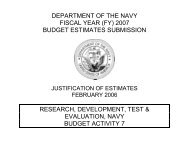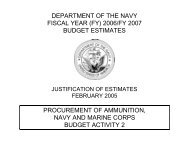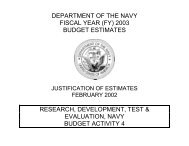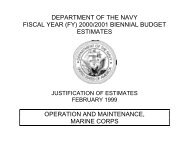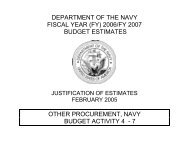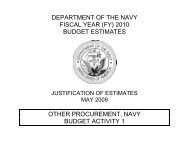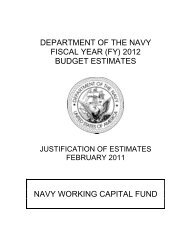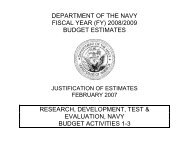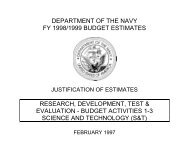Budget Highlights Book - DON FM&C Website - U.S. Navy
Budget Highlights Book - DON FM&C Website - U.S. Navy
Budget Highlights Book - DON FM&C Website - U.S. Navy
You also want an ePaper? Increase the reach of your titles
YUMPU automatically turns print PDFs into web optimized ePapers that Google loves.
Revitalizing the Force Ashore February 2010elements. Ensuring the right material is provided at the proper place, time, and costis vital to equipping and sustaining our warfighting units. <strong>Navy</strong> Supply continuesdeployment of the <strong>Navy</strong> Enterprise Resource Planning (ERP) system.Implementation at the Naval Inventory Control Point began in FY 2010 andcontinues through FY 2011. Three Fleet Industrial Supply Centers (FISCs) will alsocomplete implementation in FY 2011 and the final FISCs, Yokosuka and Sigonella,go live in FY 2012. The phase implementation was scheduled in order to minimizeany impact to the fleet.During this period, the major cost drivers in the supply management inventory areaviation weapons systems for the F/A‐18, H‐60, and the H‐53. Inventory supportingaircraft engines also continues to be a major component of the overall supplymanagement inventory. Additionally, repair and parts demand for the newlysupported V‐22 Osprey have exceeded original forecasts and significantly increasedanticipated costs. The Marine Corps is leading a joint program for procurement ofspares for the Mine Resistant Ambush Protected (MRAP) vehicles while alsosupporting increased customer provisioning and replenishment spares requirementsfor other systems.Depot MaintenanceDepot maintenance functions performed by the Fleet Readiness Centers (FRCs) andMarine Corps Depots ensure that the right types and quantities of weapons systemsand support equipment are repaired, overhauled and updated on schedule so thatdeployed and soon‐to‐deploy units have the battle‐ready items they need to fightand win both ongoing OCO engagements and anypotential confrontations. Depot Maintenancepersonnel not only perform these functions at themajor activity sites, there are also a number offorward‐deployed individuals that perform timecriticalrepair and upgrade functions in‐theater,enduring the same kinds of physical conditions asthe service members they support.The FRCs are a core industrial base essential for mobilization; repair of aircraft,engines, and components; and the manufacture of parts and assemblies. Theyprovide engineering services in the development of hardware design changes andfurnish technical and other professional services on maintenance and logisticsissues. The FRCs provide important support to fleet operations by overhauling andrepairing a wide range of equipment and components. Workload budgeted in FY6‐12 FY 2011 Department of the <strong>Navy</strong> <strong>Budget</strong>



